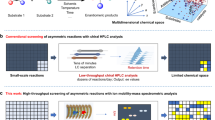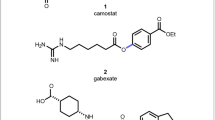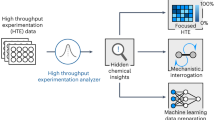Abstract
The identification of new reactions expands our knowledge of chemical reactivity and enables new synthetic applications. Accelerating the pace of this discovery process remains challenging. We describe a highly effective and simple platform for screening a large number of potential chemical reactions in order to discover and optimize previously unknown catalytic transformations, thereby revealing new chemical reactivity. Our strategy is based on labelling one of the reactants with a polyaromatic chemical tag, which selectively undergoes a photoionization/desorption process upon laser irradiation, without the assistance of an external matrix, and enables rapid mass spectrometric detection of any products originating from such labelled reactants in complex reaction mixtures without any chromatographic separation. This method was successfully used for high-throughput discovery and subsequent optimization of two previously unknown benzannulation reactions.
This is a preview of subscription content, access via your institution
Access options
Subscribe to this journal
Receive 12 print issues and online access
$259.00 per year
only $21.58 per issue
Buy this article
- Purchase on Springer Link
- Instant access to full article PDF
Prices may be subject to local taxes which are calculated during checkout




Similar content being viewed by others
References
Kanan, M. W., Rozenman, M. M., Sakurai, K., Snyder, T. M. & Liu, D. R. Reaction discovery enabled by DNA-templated synthesis and in vitro selection. Nature 431, 545–549 (2004).
Beeler, A. B., Su, S., Singleton, C. A. & Porco, J. A. Jr. Discovery of chemical reactions through multidimensional screening. J. Am. Chem. Soc. 129, 1413–1419 (2007).
Rozenman, M. M., Kanan, M. W. & Liu, D. R. Development and initial application of a hybridization-independent, DNA-encoded reaction discovery system compatible with organic solvents. J. Am. Chem. Soc. 129, 14933–14938 (2007).
Goodell, J. R. et al. Development of an automated microfluidic reaction platform for multidimensional screening: reaction discovery employing bicyclo[3.2.1]octanoid scaffolds. J. Org. Chem. 74, 6169–6180 (2009).
Mueller, C. A., Markert, C., Teichert, A. M. & Pfaltz, A. Mass spectrometric screening of chiral catalysts and catalyst mixtures. Chem. Commun. 13, 1607–1618 (2009).
Wassenaar, J. et al. Catalyst selection based on intermediate stability measured by mass spectrometry. Nature Chem. 2, 417–420 (2010).
Ebner, C., Muller, C. A., Markert, C. & Pfaltz, A. Determining the enantioselectivity of chiral catalysts by mass spectrometric screening of their racemic forms. J. Am. Chem. Soc. 133, 4710–4713 (2011).
Chen, Y., Kamlet, A. S., Steinman, J. B. & Liu, D. R. A biomolecule-compatible visible-light-induced azide reduction from a DNA-encoded reaction-discovery system. Nature Chem. 3, 146–153 (2011).
Robbins, D. W. & Hartwig, J. F. A simple, multidimensional approach to high-throughput discovery of catalytic reactions. Science 333, 1423–1427 (2011).
McNally, A., Prier, C. K. & MacMillan, D. W. C. Discovery of an α-amino C–H arylation reaction using the strategy of accelerated serendipity. Science 334, 1114–1117 (2011).
Friest, J. A., Broussy, S., Chung, W. J. & Berkowitz, D. B. Combinatorial catalysis employing a visible enzymatic reacon in real time: synthetically versatile (pseudo)halometalation/carbocyclizations. Angew. Chem. Int. Ed. 50, 8895–8899 (2011).
Montavon, T. J., Li, J., Cabrera-Pardo, J. R., Mrksich, M. & Kozmin, S. A. Three-component reaction discovery enabled by mass spectrometry of self-assembled monolayers. Nature Chem. 4, 45–51 (2012).
Senkan, S. M. High-throughput screening of solid-state catalyst libraries. Nature 394, 350–353 (1998).
Yoshino, K., Takao, T., Murata, H. & Shimonishi, Y. Use of the derivatizing agent, 4-aminobenzoic acid 2-(diethylamino)ethyl ester, for high-sensitivity detection of oligosaccharides by electrospray ionization mass spectrometry. Anal. Chem. 67, 4028–4031 (1995).
Ahn, Y. H. & Yoo, J. S. Malononitrile as a new derivatizing reagent for high-sensitivity analysis of oligosaccharides by electrospray ionization mass spectrometry. Rapid Commun. Mass Spectrom. 12, 2011–2015 (1998).
Szewczyk, J. W., Zuckerman, R. L., Bergman, R. G. & Ellman, J. A. A mass spectrometric labeling strategy for high-throughput reaction evaluation and optimization: exploring C–H Activation. Angew. Chem. Int. Ed. 40, 216–219 (2001).
Bernad, P. L. Jr, Khan, S., Korshun, V. A., Southern, E. M. & Shchepinov, M. S. S(O)-Pixyl protecting group as efficient mass-tag. Chem. Commun. 3466–3468 (2005).
Thuong, M. B. T. et al. Trimethoxyarene as highly ionizable tag for reaction analysis by atmospheric pressure photoionization mass spectrometry (APPI/MS): exploration of heterocylic synthesis. Eur. J. Org. Chem. 2012, 85–92.
McCarley, T. D., McCarley, R. L. & Limbach, P. A. Electron-transfer ionization in matrix-assisted laser desorption/ionization mass spectrometry. Anal. Chem. 70, 4376–4379 (1998).
Macha, S. F., McCarley, T. D. & Limbach, P. A. Influence of ionization energy on charge-transfer ionization in matrix-assisted laser desorption/ionization mass spectrometry. Anal. Chim. Acta 397, 235–245 (1999).
Zhang, L. & Kozmin, S. A. Brønsted acid-promoted cyclizations of siloxyalkynes with arenes and alkenes. J. Am. Chem. Soc. 126, 10204–10205 (2004).
Zhang, L. & Kozmin, S. A. Gold-catalyzed cycloisomerizations of siloxy enynes to cyclohexadienes. J. Am. Chem. Soc. 126, 11806–11807 (2004).
Sweis, R., Schramm, M. P. & Kozmin, S. A. Silver-catalyzed [2+2] cycloadditions of siloxyalkynes. J. Am. Chem. Soc. 126, 7442–7443 (2004).
Sun, J. & Kozmin, S. A. Brønsted acid-promoted cyclizations of 1-siloxy-1,5-diynes. J. Am. Chem. Soc. 127, 13512–13513 (2005).
Sun, J. & Kozmin, S. A. Silver-catalyzed hydroamination of siloxy alkynes. Angew. Chem. Int. Ed. 45, 4991–4993 (2006).
Turkmen, Y., Montavon, T. J., Kozmin, S. A. & Rawal, V. H. Silver-catalyzed inverse electron-demand Diels–Alder reaction of 1,2-diazines with siloxy alkynes. J. Am. Chem. Soc. 134, 9062–9065 (2012).
Afarinkia, K., Vinader, V., Nelson, T. D. & Posner, G. H. Diels–Alder cycloadditions of 2-pyrones and 2-pyridones. Tetrahedron 48, 9111–9171 (1992).
Danheiser, R. L. & Gee, S. K. A regiocontrolled annulation approach to highly substituted aromatic compounds. J. Org. Chem. 49, 1672–1674 (1984).
Danheiser, R. L., Nishida, A. N., Savariar, S. & Trova, M. P. Trialkylsilyloxyalkynes: synthesis and aromatic annulation reactions. Tetrahedron Lett. 29, 4917–4920 (1988).
Acknowledgements
This work was funded by the National Institutes of Health (P50 GM086145) and the Chicago Biomedical Consortium, with support from the Searle Funds at the Chicago Community Trust. The authors thank I. Steele for X-ray crystallographic analysis.
Author information
Authors and Affiliations
Contributions
J.R.C.-P. developed the reaction-screening platform, and performed and analysed all reactions using MS. D.I.C and S.L. carried out the reaction optimization and scope studies. M.M. provided assistance with instrumentation and data analysis. S.A.K. provided overall management of the project. The manuscript was written by S.A.K., M.M., J.R.C.-P. and D.I.C.
Corresponding author
Ethics declarations
Competing interests
The authors declare no competing financial interests.
Supplementary information
Supplementary information
Supplementary information (PDF 5314 kb)
Supplementary information
Crystallographic data for compound 10a (CIF 10 kb)
Supplementary information
Crystallographic data for compound 10e (CIF 12 kb)
Supplementary information
Crystallographic data for compound 13a (CIF 12 kb)
Supplementary information
Crystallographic data for compound 13f (CIF 29 kb)
Rights and permissions
About this article
Cite this article
Cabrera-Pardo, J., Chai, D., Liu, S. et al. Label-assisted mass spectrometry for the acceleration of reaction discovery and optimization. Nature Chem 5, 423–427 (2013). https://doi.org/10.1038/nchem.1612
Received:
Accepted:
Published:
Issue Date:
DOI: https://doi.org/10.1038/nchem.1612
This article is cited by
-
Skeletal editing of pyridines through atom-pair swap from CN to CC
Nature Chemistry (2024)
-
Ultra-high-throughput mapping of the chemical space of asymmetric catalysis enables accelerated reaction discovery
Nature Communications (2023)
-
Screening and characterization of a diverse panel of metagenomic imine reductases for biocatalytic reductive amination
Nature Chemistry (2021)
-
N,N-Dimethylaminopyrene as a fluorescent affinity mass tag for ligand-binding mode analysis
Scientific Reports (2020)
-
Quantitation of Glutathione by Quinoline-5, 8-Dione-Based Tag Strategy Using MALDI Mass Spectrometry
Journal of the American Society for Mass Spectrometry (2019)



